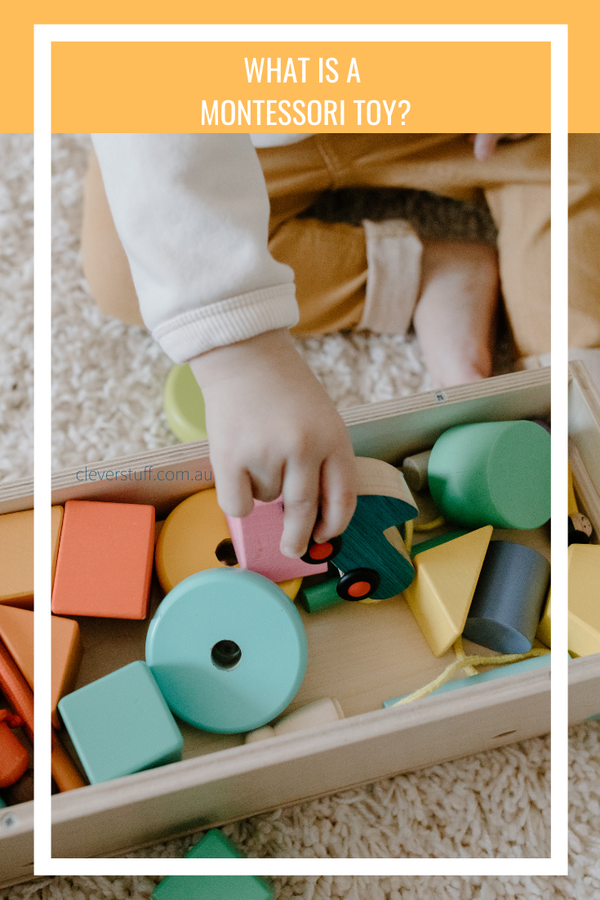What is a Montessori Toy is a question we are asked often. When it comes down to it, there is no such thing as a Montessori Toy, however, there are toys that are more closely aligned with the learning philosophy of Maria Montessori. There are key principles that make a toy ‘more Montessori’ than another. Here are a few factors to consider when we are asking ‘is this a Montessori inspired toy?’
When we ask ourselves what a Montessori toy is, we can look at the following elements.
- Simplicity – A Montessori Toy will focus on one skill at a time. Children have such a limited understanding of the world around them, if you provide toys with too much complexity, colour or tasks to complete, children cannot work on the essential elements of the activity. A puzzle with just 4 shapes may look too simple to an adult, but to a child learning shapes or colours, this is just enough information for them to learn without being overwhelmed. Further to the simplicity of the toy itself, the amount of toys in the playroom as a whole is also important – it’s a matter of quality over quantity. Rotate toys, carefully select toys to work on each skill and watch your child develop through their use of their Montessori toys.
- Natural materials –Montessori toys are typically made from natural materials such as wood, wicker, cotton, metal, and glass. Beyond their educational value, toys made of these materials provide a multi-sensory experience for the child. Glass (although controversial to give to children) will teach children to be more gentle than a plastic cup for example that they can throw, drop or knock over without damage. We don’t stock glass items at CleverStuff and as with all toys, close supervision is a must.
- Encourage Active Play – all the toys we give our children should require their participation and action for use – children learn by doing, by making mistakes and correcting themselves. The best Montessori toys for the development of children will allow them to explore and experiment and actively engage with the toy. Children should not be passive spectators to an adult’s idea about how to play. When your child is given unstructured opportunity to play, they will build and interact, learning about their world and their capabilities.

- Functional – Giving children toys with real consequences is a must for their cognitive development. Skip the boxes with knobs and buttons that produce unrelated and random noises, lights that flash and bright, coloured images. Encourage your child to play with toys that demonstrate cause and effect such as a car carriage dropped down a ramp and emerge at the other end, or a jingle bell stick that will ring and chime when your baby plays with it. Toys like this will allow your child to learn the true meaning of cause and effect – a skill they will use for a lifetime.
- Based in Real Life – Montessori Toys are a wonderful way to help your child learn real life skills that every one needs as they grow. Buttoning and lacing toys, scissors for cutting, toys that require sizing or sequencing – these are all fantastic opportunities for children to learn life skills. A Montessori toy will encourage learning by doing – using a toy that your child can hold, touch and manipulate to achieve a goal will not only develop skills but assist in your child’s growing sense of independence.

- Allow for Experimentation – A Montessori toy will be deeply rooted in gaining skills and encourage your child to develop their creativity and allow them to explore while experimenting. The toy should also give them the opportunity to work independently at their own pace and use their creativity. Blocks and a tub of Lego bricks would be considered items that adhere to the Montessori philosophies, however, a Lego set that has detailed, step by step instructions would not allow your child to explore and experiment.
- Quality over Quantity – it is better to have a few, high quality toys over many, overstimulating and overcomplicated ones. Children are curious from the moment they are born. Children see a block and in their imagination it could be a car, a plane or a cow! Don’t extinguish your child’s innate and inherent curiosity, instead, encourage it by providing simple and open ended toys to develop their creativity, understanding of the world around them and ultimately, to allow them to learn important life skills.

Overall, when you introduce Montessori style learning toys into your child’s playroom, your classroom or your home, you are providing your child a wonderful opportunity to learn and grow through play. When looking at what toys to give to your child, if you look at the above characteristics you won’t go wrong.
If you would like to see a range of Montessori Inspired Toys – check them all out here.

